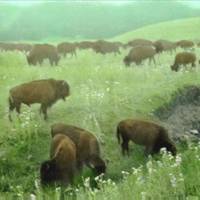 |

草原上正在吃草的水牛
南達科塔(South
Dakota)

|
 |
|
 |
水牛獵人
在這趟水牛狩獵之行,雖然沒有宰殺很多水牛,但野牛比爾一生中的確殺了數千頭水牛;他17個月內就殺了4,280頭水牛,到了1870年,大草原上的北美野牛(水牛的學名)
群已被劃分成二,分別座落於太平洋聯合鐵路線 (Union
Pacific railway line) 的南北兩
邊;1875年時,位於南邊的水牛群已遭完全撲殺,而位於北邊的水牛群則於1885年時滅絕;到了1889年,美國境內的水牛數只剩835隻;
時至今日,當20,000多
頭草原水牛正由政府有計劃的進行繁殖時,另一種水牛:林地野牛 (woodland
bison) ,仍
然是屬瀕臨絕種的物種。
Although they didn't kill many buffalo on this hunt, Buffalo Bill killed thousands during his lifetime. He killed 4,280 buffalo in 17 months alone. By 1870, the bison (the scientific name for buffalo) population of the Great Plains had been divided into two sections on either side of the Union Pacific railway line--the northern herd and the southern herd. The southern herd was completely killed by 1875 and the northern herd by 1885. By 1889, only 835 bison were left alive in the U.S. Today, one variety, the woodland bison, is still an endangered species while over 20,000 plains bison thrive in managed herds.

 3/3頁 3/3頁

|





